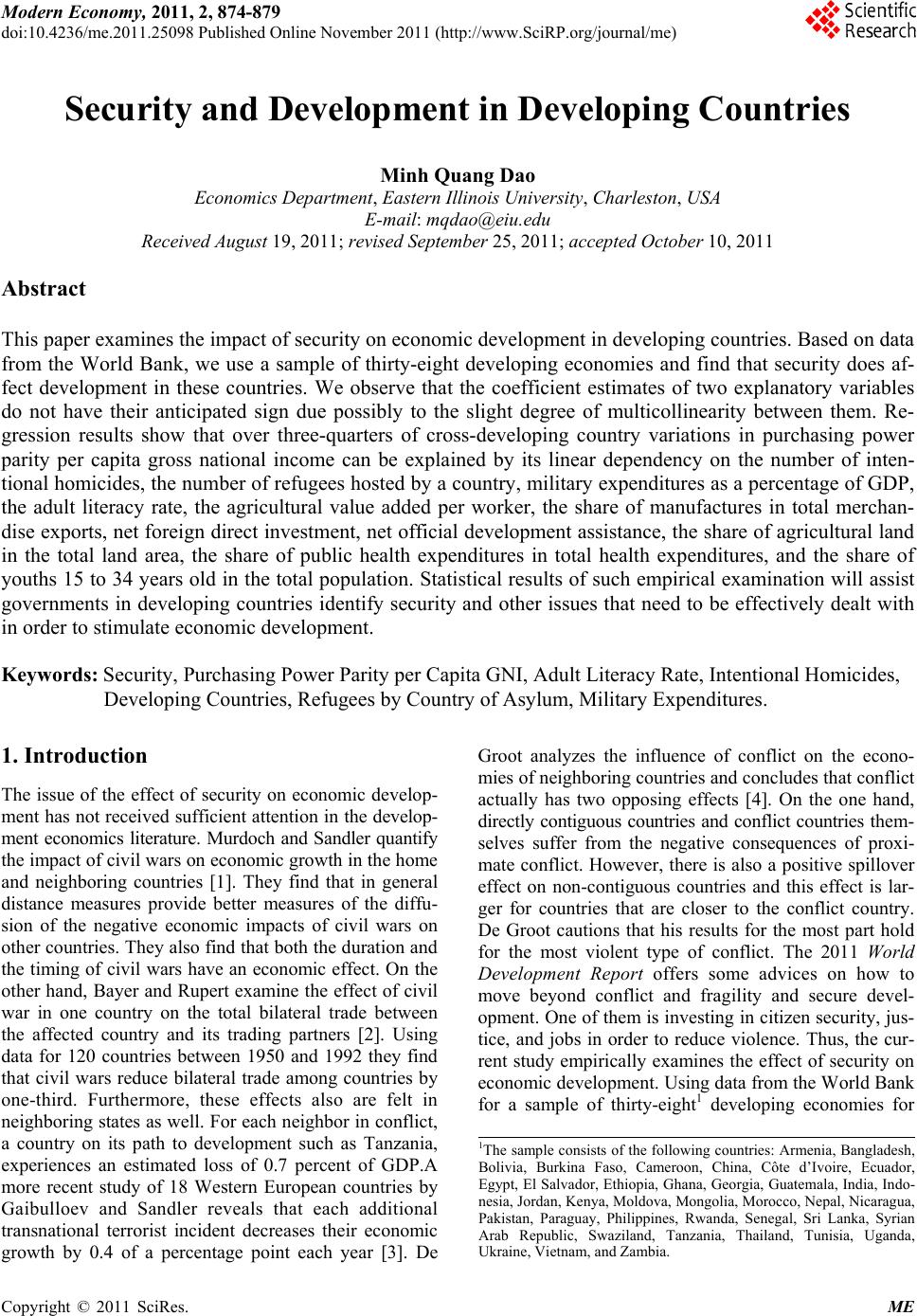
Modern Economy, 2011, 2, 874-879
doi:10.4236/me.2011.25098 Published Online November 2011 (http://www.SciRP.org/journal/me)
Copyright © 2011 SciRes. ME
Security and Development in Developing Countries
Minh Quang Dao
Economics Department, Eastern Illinois University, Charleston, USA
E-mail: mqdao@eiu.edu
Received August 19, 2011; revised Septembe r 25, 2011; accepted Octo ber 10, 2011
Abstract
This paper examines the impact of security on economic development in developing countries. Based on data
from the World Bank, we use a sample of thirty-eight developing economies and find that security does af-
fect development in these countries. We observe that the coefficient estimates of two explanatory variables
do not have their anticipated sign due possibly to the slight degree of multicollinearity between them. Re-
gression results show that over three-quarters of cross-developing country variations in purchasing power
parity per capita gross national income can be explained by its linear dependency on the number of inten-
tional homicides, the number of refugees hosted by a country, military expenditures as a percentage of GDP,
the adult literacy rate, the agricultural value added per worker, the share of manufactures in total merchan-
dise exports, net foreign direct investment, net official development assistance, the share of agricultural land
in the total land area, the share of public health expenditures in total health expenditures, and the share of
youths 15 to 34 years old in the total population. Statistical results of such empirical examination will assist
governments in developing countries identify security and other issues that need to be effectively dealt with
in order to stimulate economic development.
Keywords: Security, Purchasing Power Parity per Capita GNI, Adult Literacy Rate, Intentional Homicides,
Developing Countries, Refugees by Country of Asylum, Military Expenditures.
1. Introduction
The issue of the effect of security on economic develop-
ment has not received sufficient attention in the develop-
ment economics literature. Murdoch and Sandler quantify
the impact of civil wars on economic growth in the home
and neighboring countries [1]. They find that in general
distance measures provide better measures of the diffu-
sion of the negative economic impacts of civil wars on
other countries. They also find that both th e duration and
the timing of civil wars have an economic effect. On the
other hand, Bayer and Rupert examine the effect of civil
war in one country on the total bilateral trade between
the affected country and its trading partners [2]. Using
data for 120 countries between 1950 and 1992 they find
that civil wars reduce bilateral trade among countries by
one-third. Furthermore, these effects also are felt in
neighboring states as well. For each neighbo r in conflict,
a country on its path to development such as Tanzania,
experiences an estimated loss of 0.7 percent of GDP.A
more recent study of 18 Western European countries by
Gaibulloev and Sandler reveals that each additional
transnational terrorist incident decreases their economic
growth by 0.4 of a percentage point each year [3]. De
Groot analyzes the influence of conflict on the econo-
mies of neighboring countries and concludes that conflict
actually has two opposing effects [4]. On the one hand,
directly contiguous countries and conflict countries them-
selves suffer from the negative consequences of proxi-
mate conflict. However, there is also a positive spillover
effect on non-contiguous countries and this effect is lar-
ger for countries that are closer to the conflict country.
De Groot cautions that his results for the most part hold
for the most violent type of conflict. The 2011 World
Development Report offers some advices on how to
move beyond conflict and fragility and secure devel-
opment. One of them is investing in citizen security, jus-
tice, and jobs in order to reduce violence. Thus, the cur-
rent study empirically examines the effect of security on
economic development. Using data from the World Bank
for a sample of thirty-eight1 developing economies for
1The sample consists of the following countries: Armenia, Bangladesh,
Bolivia, Burkina Faso, Cameroon, China, Côte d’Ivoire, Ecuador,
Egypt, El Salvador, Ethiopia, Ghana, Georgia, Guatemala, India, Indo-
nesia, Jordan, Kenya, Moldova, Mongolia, Morocco, Nepal, Nicaragua,
Pakistan, Paraguay, Philippines, Rwanda, Senegal, Sri Lanka, Syrian
Arab Republic, Swaziland, Tanzania, Thailand, Tunisia, Uganda,
Ukraine, Vietnam, and Zambia.